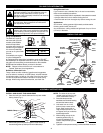
9
Cutting Blade Operating Tips
To establish a rhythmic
cutting procedure:
• Plant feet firmly,
comfortably apart.
• Bring the engine to full
throttle before entering
the material to be cut.
At full throttle the
blade has maximum
cutting power and is
less likely to bind, stall
or cause blade thrust
(which can result in
serious personal injury
to the operator or
others).
• Cut while swinging the upper part of your body from left to
right
• Always release the throttle trigger and allow the engine to
return to idle speed when not cutting.
• When you are finished, always unsnap the unit from the
harness before taking off the harness.
OPERATING INSTRUCTIONS
CAUTION: Bl
ade thrust may occur when the
spinning blade contacts an object that it does not
immediately cut. Blade thrust can be violent enough
to cause the unit and/or operator to be propelled in
any direction, and possibly lose control of the unit.
Blade thrust can occur without warning if the blade
snags, stalls or binds. This is more likely to occur in
areas where it is difficult to see the material being cut.
WARNING:
The blade continues to spin after the
engine is turned off. The coasting blade can
seriously cut you if accidentally touched.
Fig. 21
• Swing the unit in the opposite direction as the blade spins,
which increases the cutting action.
• After the return swing, move forward to the next area to be
cut plant your feet again.
• The cutting blade is designed with a second cutting edge.
You can use it by removing the blade, turning it upside
down, and reinstalling it.
To reduce the chance of material wrapping around the blade,
follow these steps:
• Cut at full throttle
• Swing the unit into material to be cut from your left to your
right (Fig. 22)
• Avoid the material just cut as you make the return swing
WARNING: Do not sharpen the cutting blade.
Sharpening the blade can cause the blade tip to
break off while in use. This can result in severe
personal injury to yourself or others. Replace the
blade.
Fig. 22
MAINTENANCE AND REPAIR INSTRUCTIONS
MAINTENANCE SCHEDULE
Perform these required maintenance procedures at the
frequency stated in the table. These procedures should also be
a part of any seasonal tune-up.
NOTE: Some maintenance procedures may require spe-
cial tools or skills. If you are unsure about these pro-
cedures take your unit to any non-road engine repair
establishment, individual or authorized service dealer.
NOTE: Maintenance, replacement, or repair of the emis-
sion control devices and system may be performed
by any non-road engine repair establishment, individ-
ual or authorized service dealer.
In order to assure peak performance of your engine, inspection
of the engine exhaust port may be necessary after 50 hours of
operation. If you notice lost RPM, poor performance or general
lack of acceleration, this service may be required. If you feel
your engine is in need of this inspection, refer service to any
non-road engine repair establishment, individual or authorized
service dealer for repair. DO NOT attempt to perform this
process yourself as engine damage may result from
contaminants involved in the cleaning process for the port.
WARNING: To prevent serious injury, never
perform maintenance or repairs with unit running.
Always service and repair a cool unit. Disconnect
the spark plug wire to ensure that the unit cannot
start.
CAUTION: Do not clear away any cut material
with the engine running or blade turning. To avoid
serious personal injury, turn off the engine. Allow
the blade to stop before removing materials
wrapped around the blade shaft.
FREQUENCY MAINTENANCE REQUIRED REFER TO
Before starting engine Fill fuel tank with fresh fuel Page 3, 4
Every 10 hours Clean and re-oil air filter Page 11
Every 25 hours
Check and clean spark arrestor
Check spark plug condition and gap
Page 12
Page 13
Every 50 hours
Inspect exhaust port and spark arrestor screen for clogging or
obstruction to assure maximum performance levels
Page 12


















